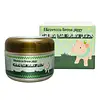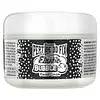What's inside
What's inside
 Key Ingredients
Key Ingredients

 Benefits
Benefits

 Concerns
Concerns

 Ingredients Side-by-side
Ingredients Side-by-side

Hydrolyzed Collagen
EmollientWater
Skin ConditioningDipropylene Glycol
HumectantPEG-240/Hdi Copolymer Bis-Decyltetradeceth-20 Ether
StabilisingGlycerin
HumectantGlyceryl Stearate
EmollientPEG-100 Stearate
Caprylic/Capric Triglyceride
MaskingMacadamia Ternifolia Seed Oil
EmollientDimethicone
EmollientMethylparaben
PreservativeSodium Hyaluronate
HumectantPhenoxyethanol
PreservativeAllantoin
Skin ConditioningTheobroma Cacao Extract
Skin ConditioningTocopheryl Acetate
AntioxidantPolyglutamic Acid
Skin ConditioningBacillus/Soybean Ferment Extract
Skin ConditioningPropylparaben
PreservativeAdenosine
Skin ConditioningDisodium EDTA
Parfum
MaskingHydrolyzed Collagen, Water, Dipropylene Glycol, PEG-240/Hdi Copolymer Bis-Decyltetradeceth-20 Ether, Glycerin, Glyceryl Stearate, PEG-100 Stearate, Caprylic/Capric Triglyceride, Macadamia Ternifolia Seed Oil, Dimethicone, Methylparaben, Sodium Hyaluronate, Phenoxyethanol, Allantoin, Theobroma Cacao Extract, Tocopheryl Acetate, Polyglutamic Acid, Bacillus/Soybean Ferment Extract, Propylparaben, Adenosine, Disodium EDTA, Parfum
Water
Skin ConditioningCentella Asiatica Extract
CleansingCoco-Caprylate/Caprate
EmollientDipropylene Glycol
HumectantMethyl Perfluoroisobutyl Ether
SolventAmmonium Acryloyldimethyltaurate/Vp Copolymer
Camellia Japonica Seed Oil
EmollientDecyl Glucoside
CleansingNiacinamide
SmoothingGlycerin
HumectantGlycereth-26
HumectantSodium Hyaluronate
HumectantPalmitoyl Pentapeptide-4
Skin ConditioningAcetyl Hexapeptide-8
HumectantCopper Tripeptide-1
Skin ConditioningButylene Glycol
HumectantDioscorea Japonica Root Extract
Skin ConditioningCellulose Gum
Emulsion StabilisingHexylene Glycol
EmulsifyingParfum
MaskingTotarol
AntioxidantEthylhexylglycerin
Skin ConditioningSodium Myristoyl Glutamate
CleansingDecylene Glycol
Skin ConditioningDipotassium Glycyrrhizate
HumectantHydrolyzed Corn Starch
HumectantBeta-Glucan
Skin ConditioningAllantoin
Skin ConditioningAdenosine
Skin ConditioningDisodium EDTA
1,2-Hexanediol
Skin ConditioningSucrose
HumectantSodium Hydroxide
BufferingAsiaticoside
AntioxidantPhenoxyethanol
PreservativeCaprylyl Glycol
EmollientAstragalus Membranaceus Root Extract
EmollientCnidium Officinale Root Extract
Skin ConditioningAngelica Gigas Root Extract
Skin ConditioningRehmannia Glutinosa Root Extract
Skin ConditioningPanax Ginseng Root Extract
EmollientAtractylodes Japonica Rhizome Extract
Skin ConditioningPoria Cocos Extract
Skin ConditioningPrunus Mume Flower Extract
Skin ConditioningOenothera Biennis Seed Extract
Skin ConditioningGlycyrrhiza Glabra Root Extract
BleachingPaeonia Lactiflora Root Extract
Skin ConditioningCinnamomum Cassia Bark Extract
MaskingCI 42090
Cosmetic ColorantSh-Oligopeptide-1
Skin ConditioningWater, Centella Asiatica Extract, Coco-Caprylate/Caprate, Dipropylene Glycol, Methyl Perfluoroisobutyl Ether, Ammonium Acryloyldimethyltaurate/Vp Copolymer, Camellia Japonica Seed Oil, Decyl Glucoside, Niacinamide, Glycerin, Glycereth-26, Sodium Hyaluronate, Palmitoyl Pentapeptide-4, Acetyl Hexapeptide-8, Copper Tripeptide-1, Butylene Glycol, Dioscorea Japonica Root Extract, Cellulose Gum, Hexylene Glycol, Parfum, Totarol, Ethylhexylglycerin, Sodium Myristoyl Glutamate, Decylene Glycol, Dipotassium Glycyrrhizate, Hydrolyzed Corn Starch, Beta-Glucan, Allantoin, Adenosine, Disodium EDTA, 1,2-Hexanediol, Sucrose, Sodium Hydroxide, Asiaticoside, Phenoxyethanol, Caprylyl Glycol, Astragalus Membranaceus Root Extract, Cnidium Officinale Root Extract, Angelica Gigas Root Extract, Rehmannia Glutinosa Root Extract, Panax Ginseng Root Extract, Atractylodes Japonica Rhizome Extract, Poria Cocos Extract, Prunus Mume Flower Extract, Oenothera Biennis Seed Extract, Glycyrrhiza Glabra Root Extract, Paeonia Lactiflora Root Extract, Cinnamomum Cassia Bark Extract, CI 42090, Sh-Oligopeptide-1
 Reviews
Reviews

Ingredients Explained
These ingredients are found in both products.
Ingredients higher up in an ingredient list are typically present in a larger amount.
Adenosine is in every living organism. It is one of four components in nucleic acids that helps store our DNA.
Adenosine has many benefits when used. These benefits include hydrating the skin, smoothing skin, and reducing wrinkles. Once applied, adenosine increases collagen production. It also helps with improving firmness and tissue repair.
Studies have found adenosine may also help with wound healing.
In skincare products, Adenosine is usually derived from yeast.
Learn more about AdenosineAllantoin is a soothing ingredient known for its protective and moisturizingg properties. Because of this, it is often added to products with strong active ingredients.
Studies show higher concentrations of this ingredient can promote wound healing.
Though it can be derived from the comfrey plant, allantoin is produced synthetically for cosmetic products to ensure purity.
Learn more about AllantoinDipropylene Glycol is a synthetically created humectant, stabilizer, and solvent.
This ingredient helps:
Dipropylene glycol is technically an alcohol, but it belongs to the glycol family (often considered part of the ‘good’ alcohols). This means it is hydrating and gentle on skin unlike drying solvent alcohols like denatured alcohol.
As a masking agent, Dipropylene Glycol can be used to cover the smell of other ingredients. However, it does not have a scent.
Studies show Dipropylene Glycol is considered safe to use in skincare.
Learn more about Dipropylene GlycolDisodium EDTA plays a role in making products more stable by aiding other preservatives.
It is a chelating agent, meaning it neutralizes metal ions that may be found in a product.
Disodium EDTA is a salt of edetic acid and is found to be safe in cosmetic ingredients.
Learn more about Disodium EDTAGlycerin is already naturally found in your skin. It helps moisturize and protect your skin.
A study from 2016 found glycerin to be more effective as a humectant than AHAs and hyaluronic acid.
As a humectant, it helps the skin stay hydrated by pulling moisture to your skin. The low molecular weight of glycerin allows it to pull moisture into the deeper layers of your skin.
Hydrated skin improves your skin barrier; Your skin barrier helps protect against irritants and bacteria.
Glycerin has also been found to have antimicrobial and antiviral properties. Due to these properties, glycerin is often used in wound and burn treatments.
In cosmetics, glycerin is usually derived from plants such as soybean or palm. However, it can also be sourced from animals, such as tallow or animal fat.
This ingredient is organic, colorless, odorless, and non-toxic.
Glycerin is the name for this ingredient in American English. British English uses Glycerol/Glycerine.
Learn more about GlycerinParfum is a catch-all term for an ingredient or more that is used to give a scent to products.
Also called "fragrance", this ingredient can be a blend of hundreds of chemicals or plant oils. This means every product with "fragrance" or "parfum" in the ingredients list is a different mixture.
For instance, Habanolide is a proprietary trade name for a specific aroma chemical. When used as a fragrance ingredient in cosmetics, most aroma chemicals fall under the broad labeling category of “FRAGRANCE” or “PARFUM” according to EU and US regulations.
The term 'parfum' or 'fragrance' is not regulated in many countries. In many cases, it is up to the brand to define this term.
For instance, many brands choose to label themselves as "fragrance-free" because they are not using synthetic fragrances. However, their products may still contain ingredients such as essential oils that are considered a fragrance by INCI standards.
One example is Calendula flower extract. Calendula is an essential oil that still imparts a scent or 'fragrance'.
Depending on the blend, the ingredients in the mixture can cause allergies and sensitivities on the skin. Some ingredients that are known EU allergens include linalool and citronellol.
Parfum can also be used to mask or cover an unpleasant scent.
The bottom line is: not all fragrances/parfum/ingredients are created equally. If you are worried about fragrances, we recommend taking a closer look at an ingredient. And of course, we always recommend speaking with a professional.
Learn more about ParfumPhenoxyethanol is a preservative that has germicide, antimicrobial, and aromatic properties. Studies show that phenoxyethanol can prevent microbial growth. By itself, it has a scent that is similar to that of a rose.
It's often used in formulations along with Caprylyl Glycol to preserve the shelf life of products.
Sodium Hyaluronate is hyaluronic acid's salt form. It is commonly derived from the sodium salt of hyaluronic acid.
Like hyaluronic acid, it is great at holding water and acts as a humectant. This makes it a great skin hydrating ingredient.
Sodium Hyaluronate is naturally occurring in our bodies and is mostly found in eye fluid and joints.
These are some other common types of Hyaluronic Acid:
Learn more about Sodium HyaluronateWater. It's the most common cosmetic ingredient of all. You'll usually see it at the top of ingredient lists, meaning that it makes up the largest part of the product.
So why is it so popular? Water most often acts as a solvent - this means that it helps dissolve other ingredients into the formulation.
You'll also recognize water as that liquid we all need to stay alive. If you see this, drink a glass of water. Stay hydrated!
Learn more about Water